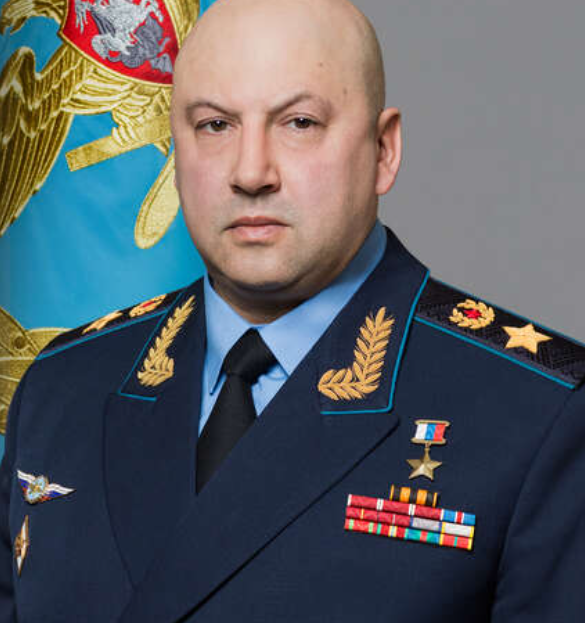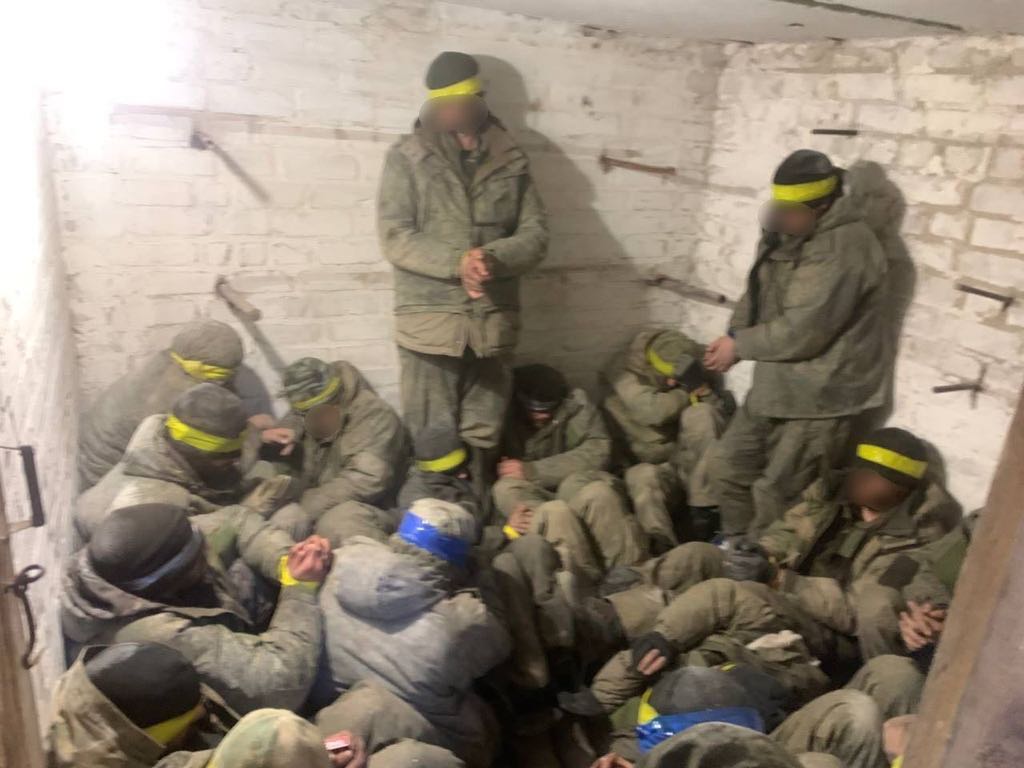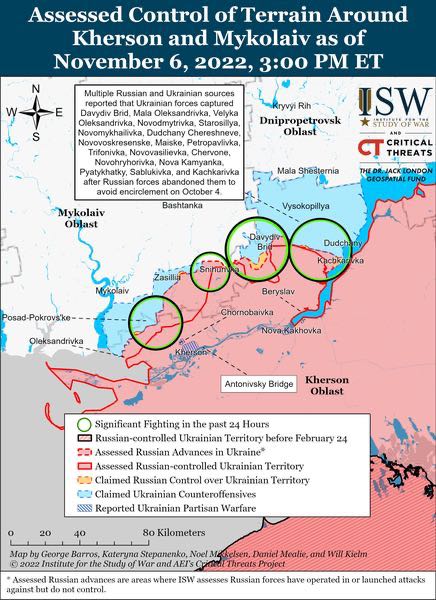Now it is clear that the Russian army is not able to wage an offensive war for lack of ammunition and sophisticated troops, the Russians change tactics. According to ex-diplomat Vladimir Frolov in an article for Carnegie Politika the idea is to buy time till spring and use evacuated Kherson as fortification and protection of free access to Crimea. New military commander Suvorikin is in charge. In the end Putin hopes the West will force Ukraine into peace talks with guarantees of new borders.
 Ukrainian minister of Defense Reznikov on 7 November announced the arrival of NASAMS and Aspide air defence systems from Norway, US and Spain (picture twitter)
Ukrainian minister of Defense Reznikov on 7 November announced the arrival of NASAMS and Aspide air defence systems from Norway, US and Spain (picture twitter)
by Vladimir Frolov
The appointment of General Sergei Surovikin as the new commander of Russia’s 'special military operation' in Ukraine, together with the elements of martial law announced by the Kremlin, gives some clues as to Russia’s medium-term military and political goals in Ukraine.
Surovikin’s strategy and mandate can be summarized as switching to strategic defense on all fronts, with the possibility of diversionary attacks and local tactical offensives to improve Russia’s positions. Russia intends to build a solid and durable line of defense in the territories it has occupied in order to prevent any major breaches by the Ukrainian armed forces or any further shifts in the new borders.
In other words, Russia aims to put a stop to the intensive fighting before winter sets in, effectively freezing the conflict and retaining the territorial gains it has made so far. That is all the Russian command is capable of right now. Certainly there is no question of any new large-scale offensive into Ukrainian territory. Russia’s critical lack of modern military hardware prevents it from being able to launch offensives against its better-equipped enemy.
Moscow needs a lengthy pause in the fighting in order to rebuild combat-ready ground troops almost from scratch. Partial mobilization was needed, as President Vladimir Putin openly said, in order to hold a front line a thousand kilometers long. The poor level of the training and equipment given to newly mobilized troops means they cannot be used in offensive operations. But to hold and control the territory occupied by Russia behind the lines, even people with fifty-year-old AKM automatic rifles will do.
The new state-of-emergency laws introduced by the Kremlin in October are also aimed at being able to provide a strategic defense of the 'captured objectives' rather than all-out warfare to the bitter end. The economic and human mobilization should make it possible to continue the simmering 'special military operation' until 2023, nothing more.
Russia intends to build a solid and durable line of defense in the territories it has occupied
The new commander for operations in Ukraine has the authority to make 'difficult decisions' on withdrawing troops to more advantageous defensive positions that the Ukrainian forces cannot penetrate. They will withdraw even if that means giving up large, symbolically important territories that are hard to defend, such as the right bank of the Dnieper River or the north of the Luhansk region. Surovikin will take responsibility for these decisions to avoid the risk of destabilization within Russia itself.
 General Suvorikin has to reassess Russia's military goals in Ukraine
General Suvorikin has to reassess Russia's military goals in Ukraine
New Goals
Surovikin has also been ordered to bring the political goals of the 'special operation' in line with Russia’s actual military and economic capacity, given that the enemy’s logistic and operational support are being provided by the entire NATO bloc at a cost of tens of billions of dollars.
The discrepancy between the strategic goals and the means allocated for achieving those goals was the main cause of Russia’s military failures from February through to September. The 'special military operation' was conceived as a way to establish Russia’s political and military control over all or most of Ukraine’s territory by bringing about regime change in Kyiv. The Kremlin was counting on being able to use a limited show of strength to force out the EU and NATO from Ukraine once and for all.
That battle was already lost by the middle of March, when Russian troops failed to enter Kyiv, and today those aims are simply unachievable. Moscow pulled back its exhausted divisions from around Kyiv, Chernihiv, and Sumy back in April, along with some divisions from around Kharkiv. In doing so, it lost any chance of dictating the terms of capitulation to Kyiv.
From April to September, the battle being fought was over the physical borders of the part of Ukraine controlled by Russian forces. By August, it was clear that the army of contract soldiers and the military hardware at their disposal were insufficient to radically expand the area controlled by Russian troops beyond what they had seized back in February and March—with the exception of the north of the Luhansk region.
In September, following the Ukrainian counteroffensive, the battle to keep hold of those newly taken territories began. Today, the fighting is to try to ensure that the area controlled by Russia remains bigger than it was on February 23, before the invasion was launched, and that it does not slide back beyond the borders established in 2014–2015.
Russia’s critical lack of modern military hardware prevents it to launch offensives against its better-equipped enemy
Putin formulated the new political goal of the 'special operation' at a recent press conference in Astana: to preserve a Russian land corridor to Crimea along the shore of the Azov Sea and along the left bank of the Dnieper River, to ensure that Kyiv no longer controls the water supply to the Crimean Peninsula.
To that end, it’s more important for Russia to control the southern cities of Mariupol, Berdyansk, Melitopol, and Nova Kakhovka than it is to control the city of Kherson further to the west, and the Donbas cities of Lysychansk and Sievierodonetsk. This is one such 'difficult decision' that Surovikin now has the authority to make himself.
This brings us to the second component of Surovikin’s strategy: to force Ukraine to stop the active phase of the war, freeze the front lines, and enter into talks on modified Russian terms reflecting the new, realistic goal of the 'special operation'. This is why Russia is targeting Ukraine’s energy infrastructure with airstrikes and drone attacks.
Severe interruptions to the electricity supply decrease Kyiv’s ability to wage war, and sooner or later will impact on supplying the troops, thereby slowing down the Ukrainian advance. Yet Russia is severely hindered by the inability of its air force and reconnaissance assets to overcome Ukraine’s air defenses and gain supremacy in the skies. The air bombardment model used in Syria—also led by Surovikin—where Russia’s opponent didn’t have a modern air defense system at its disposal, cannot be repeated in Ukraine.
To Stop or Not to Stop
There are three factors currently preventing Russia from forcing Ukraine to make peace and accept what Russia refers to as the 'new territorial realities'. The first is that the Kremlin is not prepared to fully stop its 'operation' after freezing the front lines.
The suggestion has been floated to wait for Donald Trump to get reelected, or at least for a Republican victory in the U.S. midterm elections, in the hope that this may lead to a reduction in U.S. military aid for Ukraine: something the Republican leader of the House of Representatives, Kevin McCarthy, has hinted is possible. It seems, however, that a significant part of his faction will support an anticipated allocation of $50 billion for Kyiv by the end of the year: i.e., before the Republicans gain access to the levers of power in the House in January 2023.
In any case, hope is hardly a strategy, especially when it is based on dubious analysis of U.S. politics that has already led the Kremlin down the garden path on more than one occasion. There were also hopes that the energy crisis in Europe would force the EU into talks on Ukraine with Moscow, but the EU chose to weather the economic storm instead.
The very possibility of holding substantive talks with Kyiv about 'difficult decisions' and what to do moving forward depends on whether the Kremlin is ready to stop its operation or not. For obvious reasons, a simple ceasefire—even an extended one—is of no interest to either Kyiv or its Western partners.
This leads on to the second problem. Moscow cannot unilaterally give the order for an end to hostilities so long as Kyiv is doing everything it can to liberate the territory occupied by Russia. It has another five or six weeks to continue this before the weather conditions make further advances impossible. Kyiv will have to run up against the Russian defenses, sustain greater losses, and stop to regroup before it will agree to a pause in the fighting. And that decision is out of the Kremlin’s control.
Borders and Guarantees
The third problem is linked to the Western consensus that Moscow must not acquire new territory as a result of its actions in Ukraine: the entire undertaking must end as an overall loss for the Kremlin. That means rolling borders back at least to their position on February 24, when Russia launched its invasion.
 Russian prisoners of war in Ukraine
Russian prisoners of war in Ukraine
Moscow is not prepared to accept these changes. The very least the 'special operation' must achieve is a guaranteed land corridor to Crimea, while the other borders can more or less return to where they were on February 24. The fact that the Wagner private military company is setting up—'at its own initiative'—a second line of defense along the prewar borders of the Luhansk People’s Republic (i.e., as though Sievierodonetsk had been surrendered) says a lot about the Russian command’s real defense plans.
No diplomatic resolution to the conflict is possible without one side or the other giving way on the territorial issue. And despite popular opinion to the contrary, this issue cannot be put off to a future date. Both sides need clarity and mutual agreement on where the border will be. Ukraine needs guarantees that Russia will not try to move the borders using force once again in the future, while Russia needs guarantees that Ukraine will not go to war to try to resolve the territorial issue, regardless of who is in power in Kyiv.
For now, all the solutions proposed to this problem are based on a package of Western security guarantees for Ukraine that would be pledged after Ukraine declares neutral status. In concrete terms, these guarantees would boil down to rapid consultations (in the first 24–48 hours following a Russian invasion) to agree on a raft of Western military aid for Kyiv.
In reality, they cannot be described as 'security guarantees'. If anything, they are more akin to assurances, like those offered by the Budapest Memorandum. They would provide neither the deterrence by denial nor deterrence by punishment with which NATO members are conferred.
Zelensky sees two possible ways out of the situation. The first is an accelerated accession to NATO, which to all intents and purposes has already happened: the stakes for NATO have grown so high in this conflict that they are close to the conditions laid out by Article 5 of the NATO founding treaty on collective defense, albeit without the nuclear component. Still, NATO is in no hurry to formalize Ukraine’s status.
The second possible way out is for Ukraine to become another Israel: armed to the teeth with its own and Western arms, and in a permanent state of readiness for full-scale war. The country would have to have a very strong air force, missile defense systems, and long-range missile complexes.
Obviously, the prospect of a 'Ukrainian Israel' is not something that Moscow would like to see, hence the (already unrealistic) demands for Ukraine to demilitarize. That situation would be unstable, and would guarantee another 'preventative war' at some point in the future.
Practical Alternatives
One possible alternative to Western security guarantees would be to deploy international peacekeepers to Ukraine beyond the reach of Russian artillery. This peacekeeping contingent could consist primarily of troops from NATO countries equipped with heavy weaponry: something along the lines of the Kosovo Force, KFOR.
Well-armed peacekeepers would make it possible to achieve deterrence by denial without the excessive militarization of Ukraine, and without the country formally joining NATO. The alliance’s nuclear umbrella would cover NATO peacekeepers, and by extension Ukraine.

It might seem that Moscow would be against this option: after all, Putin warned specifically in Astana that the direct involvement of NATO troops in operations against Russian troops in Ukraine could lead to the use of nuclear weapons by Moscow. But it may be possible to reach an agreement that UN/NATO troops would only be brought in following the end of active hostilities in order to guarantee the new borders of Ukraine and Russia (with a Russian corridor to Crimea), which Kyiv could recognize as part of a definitive resolution.
After all, the key Russian demand is that Ukraine recognize the new borders with Russia, and Russian sovereignty over Crimea and the territory of the land corridor connecting Crimea and Russia, as well as international guarantees that Kyiv will not use force to try to change these borders. In that case, it makes no difference whether those guarantees are provided by the UN, or directly by NATO or the EU.
Russia demands that Ukraine recognize the new borders and Russian sovereignty over Crimea and its land corridor
Even Ukraine joining the EU would mean it was covered by the union’s Article 42.7, which is similar to NATO’s Article 5. Paradoxically, as a result of its 'special military operation', Russia really will need security guarantees from the West against future revanchism by Kyiv.
Some will argue that such a resolution would look uncomfortably like the territorial division of Ukraine into zones of Russian and Western control. Yet it would also serve as protection from a repetition of current events, and would guarantee the stability of European security based on the best practices from the Cold War—for which the Russian foreign policy elite appears to be so nostalgic.
Putin has been sounding out the West on its readiness to effectively carve up Ukraine since 2008, and in recent months Moscow has repeatedly dared Warsaw to send troops 'at long last' into western Ukraine. If, therefore, it proves possible to enact this scheme via intermediaries—such as Turkish President Recep Tayyip Erdogan, or, better still, through Biden at the G20 summit—then Moscow will be the first to vote for a UN Security Council resolution on sending an UKRFOR peacekeeping contingent to western Ukraine.
This article was published by Carnegie Politika.
